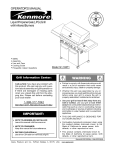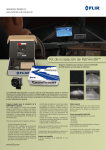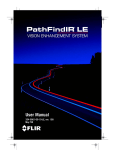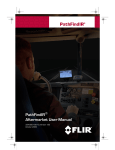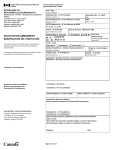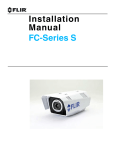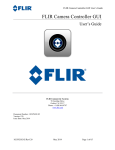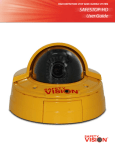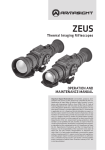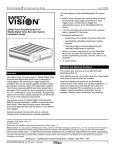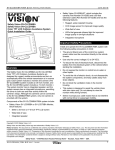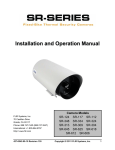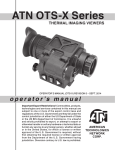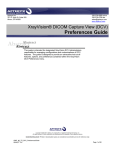Download User Manual PathFindIR II
Transcript
– User Manual PathFindIR II 334-0050-00-10, version 100 Feb 2014 i – © FLIR Systems, Inc.. All rights reserved worldwide. No parts of this manual, in whole or in part, may be copied, photocopied, translated, or transmitted to any electronic medium or machine readable form without the prior written permission of FLIR Systems, Inc. Names and marks appearing on the products herein are either registered trademarks or trademarks of FLIR Systems, Inc. and/or its subsidiaries. All other trademarks, trade names, or company names referenced herein are used for identification only and are the property of their respective owners. This product is protected by patents, design patents, patents pending, or design patents pending. FLIR Systems, Inc. 70 Castilian Drive Goleta, CA 93117 Phone: 1-877-773-FLIR (3547) www.flir.com Document: 334-0050-00-10 Version: 100 Date: Feb 2014 ii Feb 2014 334-0050-00-10, version 100 1 Warnings and Cautions 1.1 Cautions ..........................................................................................1 1.2 General Information ........................................................................2 2 Introduction 2.1 Overview .........................................................................................3 2.2 Thermal Imaging Driver Vision Enhancement System ....................4 2.2.1 PathFindIR II Camera Kit .......................................................5 2.2.2 Installation Kit ........................................................................6 2.3 What is Thermal Imaging? ..............................................................7 2.4 Vehicles that use PathFindIR II .......................................................7 2.5 PathFindIR II Part Numbers .............................................................8 3 Installation 3.1 PathFindIR II Installation .................................................................9 3.2 Preparation and Installation Considerations ....................................9 3.3 Installation Guidelines and Precautions ........................................10 3.4 PathFindIR II Installation ...............................................................12 3.5 ECU Installation ............................................................................14 3.6 Cable Connections ........................................................................15 3.7 Mounting Assistance .....................................................................16 4 Getting Started 4.1 Using your PathFindIR II ...............................................................17 4.2 Initial System Startup ....................................................................17 4.3 Automatic Shutter .........................................................................18 4.4 Heater Element .............................................................................18 4.5 Pedestrian and Animal Detection ..................................................18 4.5.1 Animal Detection .................................................................18 4.5.2 Pedestrian Detection ...........................................................19 4.6 In Case of Difficulty .......................................................................20 4.7 Troubleshooting ............................................................................21 5 Caring for your PathFindIR II 5.1 Product Cleaning ..........................................................................23 5.2 Temperature .................................................................................24 5.3 Maintenance .................................................................................24 6 Technical Data 6.1 Performance Specifications ........................................................25 6.1.1 Side View .............................................................................26 6.1.2 Rear View ............................................................................27 6.1.3 Front View ...........................................................................28 6.1.4 ECU Dimensions .................................................................29 334-0050-00-10, version 100 Feb 2014 iii iv Feb 2014 334-0050-00-10, version 100 1 Warnings and Cautions 1.1 Cautions Caution! This guide uses the term Caution to indicate a potentially hazardous situation, which, if not avoided, may result in injury, damage to the vehicle or PathFindIR II, or other property damage. Caution! The PathFindIR II thermal imaging system will automatically detect some, but not all, animals and pedestrians. The system is intended as an early warning for hazards, but it should not be used as the primary navigation method. Consult your local and state driving regulations prior to installation. In many states using active monitors in view of the driver is prohibited. Consult your local and state driving regulations for laws and guidelines. User assumes all risks and indemnifies the manufacturer from any liability. Minimize viewing of the thermal image display while driving. The PathFindIR II image is intended for occasional viewing, similar to a standard rear view mirror. Viewing the display may distract the driver from looking ahead and may result in an accident. The PathFindIR II thermal imaging system should not be used as a substitution for head lamps or head lamp assisted human vision during vehicle operation. The PathFindIR II thermal imaging system is designed for commercial, over the road, automotive applications. While many other applications are possible, you must carefully consider additional protection and installation methods that might be required for any given application. Mechanical, environmental and electrical requirements should be evaluated to assure that the PathFindIR II system can be utilized with satisfactory results. When installing the PathFindIR II, do not block the vehicle’s vents or radiator panels. Doing so may result in heat buildup, equipment breakage, and/or fire. Do not partake in any activity that takes your attention away from safely driving your vehicle. 334-0050-00-10, version 100 Feb 2014 1 1 – Warnings and Cautions Any function that requires your prolonged attention should only be performed after coming to a complete stop. Always stop the vehicle in a safe location before performing these functions. Failure to do so may result in an accident. 1.2 General Information Caution! The PathFindIR II thermal imaging system is not intended to be used as the primary navigation system. The PathFindIR II should not to be used as a substitution for head lamps or head lamp assisted human vision during vehicle operation. It should be used only as an aid to cautious night-time driving. Do not open the camera body or the ECU for any reason. Disassembly (including removal of the cover) can cause permanent damage and will void the warranty. Operating the camera and ECU outside of the specified input voltage range or the specified operating temperature range can cause permanent damage. Do not image extremely high intensity radiation sources, such as the sun, lasers, arc welders, etc. The camera is a precision optical instrument and should not be exposed to excessive shock and/or vibration. Refer to paragraph 6.1 “Performance Specifications ” on page 25 for detailed environmental requirements. Great care should be used with your camera optics. They are delicate and can be damaged by improper cleaning. Refer to Chapter 5 “Caring for your PathFindIR II” on page 23. All thermal imaging systems are subject to export control. Standard NTSC (30Hz) units are subject to export restrictions and licensing by the United States Government. Models with video frame rates at or below 9Hz do not require licensing but do require compliance with other export requirements. Please contact FLIR for details concerning export compliance for your application or geographic area. 2 Feb 2014 334-0050-00-10, version 100 2 Introduction 2.1 Overview The FLIR ThermoVision®PathFindIR II is a state-of-the-art thermal imaging system that will provide you with excellent night visibility and situational awareness, even in absolute darkness.The PathFindIR II system is designed for simple, intuitive operation and uses sophisticated video processing algorithms to provide pedestrian and animal detection. The camera is an advanced thermal sensor that converts thermal content (heat) of a scene into an image for display on a video monitor inside your vehicle. Figure 2-1: PathFindIR II Makes the Difference The above images show a comparison of typical night time driving compared to using the PathFindIR II thermal imager. The image on the left is from an ordinary camera and shows the amount of visible light as illuminated by headlights; the image on the right is a thermal image created by the PathFindIR II thermal imaging camera. The PathFindIR II camera is sensitive to warm objects, such as the deer, and provides visibility over a much greater distance. Some of the objects that are most critical for a driver to avoid are people and animals. Because these objects are naturally warm, they are particularly easy to see with the PathFindIR II and clearly stand out in the video image. The system automatically highlights detected pedestrians and animals with yellow boxes to indicate potential hazards. Many serious accidents occur at night because the driver is not able to see the cause of the accident in time to prevent the collision. PathFindIR II directly addresses this problem, allowing drivers to see farther ahead on nighttime roadways and identify potential problems earlier. The 334-0050-00-10, version 100 Feb 2014 3 2 – Introduction majority of trucking accidents occur in rural areas, where visibility is severely reduced at night. Humans and other warm blooded animals offer significant thermal contrast to driving backgrounds and are easy to spot with the PathFindIR II. The system allows drivers to see without any additional lighting and provides real-time imaging at any speed. Different than visible light cameras, thermal imagers do not display reflected light as seen with human eyes. Rather, thermal imaging cameras only 'see' temperature differences which are converted into shades of grey, from black to white. The PathFindIR II camera displays cold objects as black and hot objects as white. When using a thermal imager in darkness, the image is created based on temperature differences of objects in the field of view, rather than reflected light from headlights. Furthermore, because thermal imaging cameras only 'see' heat sources and not reflected light, they are ideal to assist with driver vision and situational awareness for oncoming obstructions such as animals, people, and other vehicles. 2.2 Thermal Imaging Driver Vision Enhancement System The FLIR Systems, Inc. PathFindIR II system is a high performance, rugged, thermal imaging camera designed to provide driver vision enhancement in adverse weather conditions and better situational awareness than with traditional head lamps. The system is comprised of two primary components: the PathFindIR II camera (or imager), and the Electronic Control Unit (ECU). These two matched components are the heart of the system. Most installations will also include a video display (also called monitor), various cables, mounting brackets and mounting hardware. 4 Feb 2014 334-0050-00-10, version 100 2 – Introduction 2.2.1 PathFindIR II Camera Kit The standard camera kit includes these components: • • • • PathFindIR II thermal imager and mounting screws ECU PathFindIR II to ECU Cable Power/Video Cable (Vehicle Power to ECU, ECU video to Display) PathFindIR Camera ECU PathFindIR to ECU Cable Power/Video Cable Table 2-1: Standard Camera Kit components The ECU connects to the vehicle power and interconnects the PathFindIR II to a video display. The ECU provides power to the camera, controls the camera operation and performs the image processing for pedestrian and animal detection functions. The ECU outputs the processed image as analog video so it can be viewed on a display system. 334-0050-00-10, version 100 Feb 2014 5 2 – Introduction 2.2.2 Installation Kit The optional Installation Kit includes these components: • SafetyVision Video Monitor, cables, adapters and mounting hardware • ECU mounting bracket and mounting screws • Camera mounting bracket and mounting screws Video Monitor ECU Bracket (with ECU installed) PathFinder Mounting Bracket Table 2-2: Optional Installation Kit components The Power/Video Cable is 20’ (6m) long and provides flying leads for power and video. It may be necessary to extend the video cable with an additional video cable to connect to the video display. It may also be necessary to provide additional power cable to extend to the power source. Refer to Chapter 3 “Installation” on page 9 for more information. It is recommended the installer should provide a system On/Off switch and in-line fuse protection. 6 Feb 2014 334-0050-00-10, version 100 2 – Introduction 2.3 What is Thermal Imaging? With our eyes, we see visible light. With a thermal imager, we can see infrared thermal energy - a form of light just beyond the visible spectrum. Thermal imagers show subtle differences in temperature; warm objects appear white and cooler objects appear black. In addition to driver vision enhancement, FLIR's thermal imaging cameras are used in a wide variety of applications, including fire fighting, security, maritime, traffic safety, industrial and medical applications. They continue to be used by militaries worldwide to navigate at night and in battlefield conditions. Over the last few years, volume production of these systems has allowed FLIR to offer the same high performance cameras designed for military use to the commercial market. Although adverse conditions such as heavy fog will affect any driver vision enhancement system, thermal imaging cameras such as the PathFindIR II have been shown to continue to provide useful information in conditions of reduced visibility, such as haze and smoke. While the PathFindIR II can assist drivers with detection of obstructions in the vehicle’s path, thermal imagers should not be used as the sole vision method of the driver. PathFindIR II is specifically designed to withstand a harsh environment, with a hermetically-sealed external housing resistant to rocks, sand, salt, and under-hood contaminants. Additionally, the wide operating temperature range allows the PathFindIR II to maintain high performance in severe weather conditions. 2.4 Vehicles that use PathFindIR II Passenger Vehicles, Commercial Trucks, Buses, and Recreational Vehicles - PathFindIR II can reduce the detection time for hazards and reduce the probability of an accident - saving lives, property, and profits. Emergency Vehicles - Emergency vehicles' high speeds and degraded stopping distances increase the chance of an accident - PathFindIR II improves hazard detection at high speeds. Commuter and Freight Trains - PathFindIR II can reveal railway obstructions at long ranges in complete darkness. This early detection capability can significantly increase reaction time depending on the size of the obstruction. Heavy Construction Vehicles - For heavy equipment navigation, PathFindIR II improves awareness in conditions that render eyesight and daylight cameras useless. The PathFindIR II can see clearly through dust and smoke, increasing safety for everyone on the job site. 334-0050-00-10, version 100 Feb 2014 7 2 – Introduction 2.5 PathFindIR II Part Numbers The Pedestrian Detection and Animal Detection (PD/AD) algorithms may be effected by the mounting height of the camera relative to the ground. For vehicles that require the imager to be mounted outside the acceptable range, FLIR recommends a version of the system without the PD/ AD processing. The following systems and accessories are available: Part Number Description 334-0050-07 PathFindIR II 30Hz, NTSC 334-0054-07 PathFindIR II 7.5Hz, NTSC 334-0052-00 PathFindIR II 30Hz, NTSC, No PD/AD 334-0056-00 PathFindIR II 7.5Hz, NTSC, No PD/AD 421-0053-00 PathFindIR IIInstallation Kit (See “Installation Kit” on page 6) 308-0240-00 PathFindIR II 20 Foot Wiring Harness, Power/Video 261-2319-00 PathFindIR II Camera Mounting Bracket 261-2270-00 PathFindIR II ECU Mounting Bracket PathFindIR II Replacement Window Uncooled thermal imaging cameras operating at 30Hz (NTSC) with a resolution of 336x256 and lower-resolution are export-controlled by the U.S. Department of Commerce. Validated export licenses must be obtained from the U.S. Department of Commerce prior to export or re-export of such devices outside of the United States. These restrictions do not control imaging cameras having a maximum frame rate equal to or less than 9 Hz. This means that thermal imaging cameras with frame rates of less than 9Hz may be exported outside of the United States without an export license FLIR employs a team of trade compliance professionals that understand the export rules and regulations, and can assist customers with their export questions and issues. When FLIR delivers a camera to a customer in the U.S. who intends to export or re-export the FLIR camera outside of the United States, whether or not the camera is integrated into another product, it is the customer’s responsibility to apply for the required export license from the appropriate department of the U.S. government. Diversion contrary to U.S. law is prohibited. 8 Feb 2014 334-0050-00-10, version 100 3 Installation 3.1 PathFindIR II Installation The PathFindIR II is a compact, sealed imaging system that fits easily behind vehicle grilles and in other compact locations. It includes an internal heater to keep the lens clear in icy conditions, and delivers superior image quality. It can be ordered as a camera module with a commercial grade cable. The PathFindIR II should be installed by an installer or dealer trained by FLIR Systems, Inc. If one is not available in your area we recommend that you use a reputable car audio/video installation shop that specializes in mobile video system integration. The wiring and installation requires special care and integration techniques. Improper installation may result in damage to the camera and may void the warranty. Some modifications to the vehicle’s exterior may be required, as well as integration into various display units, including factory LCD or aftermarket multi-functional display units. To allow the cable from the imager to connect to the ECU, it is necessary to make a hole that penetrates from the exterior of the vehicle to the passenger compartment. Ensure the cable is adequately protected from sharp edges and be sure to properly seal the opening once the cable has been installed. 3.2 Preparation and Installation Considerations The PathFindIR II camera system uses fixed focus optics with a 24° horizontal field of view. The camera uses a replaceable protective window and an integrated window heater to prevent frost/ice formation while driving. In order for the PD/AD functions to work, the camera must be mounted in a specific way. It must be within a certain range of height from the ground and the forward angle (tilt) must be set within a certain range, as described in Chapter 3.4 “PathFindIR II Installation” on page 12. For vehicles that require the imager to be mounted outside the acceptable range, FLIR recommends a version of the system without the PD/ AD processing. The ECU housing is a metal enclosure designed to be mounted in the passenger compartment of the vehicle. To prevent water intrusion or other environmental damage, do not mount the ECU in the engine compartment or on the exterior of the vehicle. The PathFindIR II camera must be connected to the ECU with the provided cable. It is not possible to extend the length of the cable or interconnect multiple cables to extend the distance between the camera and the ECU. 334-0050-00-10, version 100 Feb 2014 9 3 – Installation The ECU requires power from the vehicle to operate, and in turn the ECU provides power to the camera. It is recommended that the ECU should be protected by an in-line fuse and selectively powered on or off with a switch. The power input requirements are: • Operating voltage range: 9-16VDC continuously and 18V during 100ms • Nominal voltage is 13.5VDC • Maximum system current consumption is 1.8A The ECU must be properly grounded, as described below. The ECU housing must be grounded to the vehicle chassis, and the PathFindIR II camera must be isolated from the vehicle chassis. The optional PathFindIR II Installation Kit provides a means to ground the ECU, and the included camera bracket, with its non-conductive adjustable ball mount, will isolate the camera as required. The PathFindIR II must be mounted in a location where it is not obstructed by the windshield or other glass materials. Although glass is transparent to the human eye, it is opaque in the infrared spectrum. It is recommended that power to the monitor should be supplied separately from power to the ECU to assure clean power (low noise) to both items. Otherwise the video image may appear to have interference, ghosting, or undesirable video artifacts. Caution: Before connecting the system, disconnect all power from the battery. Failure to do so may result in shock, bodily harm, or damage to system. 3.3 Installation Guidelines and Precautions It is generally good practice to bench test the camera prior to permanently installing it in the vehicle. This will allow the installer to become familiar with all of the components, cables, and connectors. Do not splice cables or tap into existing cables for power or video. Doing so may result in shock, fire, or damage to electrical system/equipment. Power connections should be made to the fused side of the vehicle’s power distribution block. Do not install in areas where the unit will hinder vehicle operation, i.e. radiator, steering, head lamps, braking systems. Doing so may interfere with the vehicle's operation and cause an accident. Do not install in areas of high moisture, dust or air intake paths. Doing so may hinder the performance of the PathFindIR II unit and cause image degradation or window damage. 10 Feb 2014 334-0050-00-10, version 100 3 – Installation Use only authorized parts and accessories. Doing so helps assure proper mounting and connectivity and limits external issues associated with poorly secured mounting and wiring. Installation using incorrect connections may result in system malfunction or risk of shock. The proper mating connector must be used when installing the PathFindIR II. The use of other connectors may result in damage to the camera that is not covered by the limited product warranty. Disconnect the negative (-) battery terminal prior to installation. Connect the ECU to the vehicle power distribution block using an available fused (2 amp) connection. Be sure to connect each lead to the correct polarity (red-positive and black-negative). Be sure to securely mount the system to assure reliable connections and stable system performance. Record the serial number, date of purchase, location of purchase and keep in a safe place. When making connections to the vehicle’s electrical system be aware of the vehicle’s installed components (i.e. on board computer system). Do not mount a display where it will distract the driver or adversely affect the driver’s vision. The screws provided with the camera and installation kit require a #25 Torx wrench. The Power/Video Cable has a BNC connector for video output. The optional Installation Kit includes all the adapters needed to connect the system to the included monitor. It may be necessary to purchase connectors/converters to connect to aftermarket or factory-installed video monitors. Caution: Supplying power to the unit outside of the recommended and stated values will result in system malfunction and void the warranty. This may also result in excessive heat build up, shock, or fire. 334-0050-00-10, version 100 Feb 2014 11 3 – Installation 3.4 PathFindIR II Installation The imager has 4 mounting holes which accept M5 x 12mm thread-forming screws (included with the standard system). Do not exceed screw insertion depth of 8-11mm and torque of 4Nm. The imager should be mounted on the exterior of the vehicle in a high position on the front of the vehicle, typically in the grille, ideally at a height of 65cm ±15cm from the ground. The position in the grille from left to right is less important; most installations will mount in the middle or slightly toward the driver’s side. It is preferred if the imager viewing angle is similar to the driver's viewing angle. The imager must have a clear optical field of view through the vehicle's grille structure to avoid obstruction of the scene ahead of the vehicle. One end of the optional Camera Mounting Bracket connects directly to the back of the imager. The other end can be attached to the grill or other part of the vehicle, and allows the camera angle to be easily adjusted and set. Alternatively the installer may wish to fabricate a custom mounting plate or bracket to attach the imager to the vehicle. The location in the grille should be selected to avoid extreme temperatures or fast temperature change (e.g. hot air from the engine compartment). Imager location in the grille should be selected to minimize exposure to road debris, sand abrasion and stone impacts. A higher location is a better choice to avoid damage to the imager. 12 Feb 2014 334-0050-00-10, version 100 3 – Installation The alignment between the optical line of sight (LOS) and the center of the image should optimally be set by the integrator/installer as follows. • Yaw pointing error: no greater than ±2 degree (center of image to center of road), • Pitch pointing error: no greater than ±2 degree (center of image to horizon), • Roll error: < 1 degree recommended (evaluate subjectively on flat road surface) 334-0050-00-10, version 100 Feb 2014 13 3 – Installation 3.5 ECU Installation In most installations, the ECU will be mounted underneath the dashboard, in relatively close proximity to the video monitor. In most installations, the ECU is secured to the vehicle with the optional ECU Mounting Bracket and the ECU Mounting Bracket is secured to the vehicle with 4 M5 x 12mm mounting screws (included). The mounting hole diameter for the included screws should be 4.56/4.48mm (0.179/0.176in). 1 - Screw, Stainless SHC, M3 x 35mm 2 - Screw, Zinc Plt, M5 x 12mm 3 - Screw, (black), M5 x 12mm (qty 3) As shown in the drawing, a single stainless steel socket head cap screw secures a green grounding wire and the ECU to the ECU bracket. A single zinc plated pan head screw secures the other end of the grounding wire to the chassis. The dimensions of the ECU are approximately 148 x 110 x 24mm (6 x 4 x 1in). 14 Feb 2014 334-0050-00-10, version 100 3 – Installation 3.6 Cable Connections Run the PathFindIR II to ECU Cable between the camera and ECU, observing that each end of the cable can only connect to either the camera or the ECU. Connect each end of the cable making sure the connections are seated securely. Connect the Power/Video Cable to the ECU connector designated with the Power indication, as indicated with the black arrow in the image.Do NOT connect the Video/Power cable to the connector indicated with a red X. Caution: Be careful to connect the Power/Video cable to the correct ECU connector. If the cable is connected to the wrong connector and power is supplied to the ECU, it will result in permanent damage to the ECU which is not covered under warranty.. Connect the other end of the Power/Video cable as follows: • Red - VDC+ • Black - VDC• BNC - Video monitor 334-0050-00-10, version 100 Feb 2014 15 3 – Installation 3.7 Mounting Assistance The following are some general guidelines which will assist your professional service and installer with good mounting positions and connections. The PathFindIR II is a thermal imaging system. As such, it will not “see through” windows or obstructions. The system should be mounted outside the vehicle's cabin (interior) and in such a location to assure a similar driving viewing field of view as normal head lamps and human vision. FLIR Systems Inc. is not liable for any modifications made to the vehicle's body, or aftermarket parts. Owner assumes all risk when modifying vehicles body, frame, grill, or any other structure. Care should be taken when drilling or cutting into parts. Contact your vehicle manufacture to assure that the mounting location does not affect the performance, operation, or safety features of your vehicle. Mounting should be performed by a FLIR-authorized service center or professional installer of automotive aftermarket equipment. Many shops familiar with rear vision cameras will be able to assist in the mounting and location of the PathFindIR II system, as well as proper display mounting and integration. Caution: Contact your vehicle manufacture to assure that your mounting location does not affect any sensors found in bumpers or grills (such as air bag deployment devices). Mounting the PathFindIR II should never interfere with the mechanical or electrical components or airways to maintain vehicle performance or operations. 16 Feb 2014 334-0050-00-10, version 100 4 Getting Started The thermal imaging camera inside the PathFindIR II is completely sealed and extremely rugged. The camera has been qualified for operation in all types of weather conditions over the specified operating temperature range and includes an automatic window heater that will prevent icing under most conditions. 4.1 Using your PathFindIR II The PathFindIR II is easy to use, but you should take a moment to carefully read this section so you understand what is displayed on the video monitor. While the imagery on the monitor may look similar to black and white daylight video, a few tips on how to interpret the images will help you to make the most of your system. The camera automatically adjusts to changing scene conditions so no additional camera control is necessary. Scenes with familiar objects will be easy to interpret with some experience. The camera automatically optimizes the image to provide you with the best contrast in most conditions. The thermal imager inside the camera does not sense light like conventional cameras; it senses heat or temperature differences. As you experiment with the system during nighttime operation, you will notice variances in the “picture quality”; this is normal. The camera senses small “differences” in apparent radiation from the objects in view, and displays them as either white (or lighter shades of gray) for warmer objects, and black (or darker shades of gray) for colder objects. 4.2 Initial System Startup The system generally will be in one of three modes: • Off - system is not powered and not operating • Startup - the imager displays a FLIR splash screen while it performs the initialization. The Imager is initially locked until it is authorized by its matching ECU. The startup takes less than 2 seconds. • Operating - the imager has been successfully authenticated and is fully operating providing a thermal image on the video output. Make sure to test the system prior to installation to assure the system is functioning properly. Be sure to remove the protective window sticker prior to test and installation. Upon initial power up, the camera will make a slight clicking sound. This click is the internal image correction and is entirely normal and expected. This noise is the mechanical shutter assembly which causes the image to momentarily “freeze.” This noise and image freezing will occur until the unit has reached a thermally stable temperature and periodically thereafter. 334-0050-00-10, version 100 Feb 2014 17 4 – Getting Started 4.3 Automatic Shutter The PathFindIR II incorporates an automatic image correction feature via the internal calibration shutter. This shutter will activate every 2 minutes or more frequently during initial start up and large environmental temperature changes. During this function the image will be "frozen" for approximately half a second. 4.4 Heater Element The PathFindIR II has a built-in heating element to stabilize the window and prevent ice build-up in cold weather conditions. The heating element is automatically turned on when the temperature of the window falls below 4ºC and is tuned off when the temperature reaches 6ºC. 4.5 Pedestrian and Animal Detection The ECU provides a function know as the Vision Processor, which performs three main functions: • Enhance and adapt the image for the display in the vehicle • Detect and highlight pedestrians at night • Detect and highlight animals at night The system is primarily designed to detect pedestrians and animals at night time. Depending on conditions and ambient temperatures, the detection algorithms may work poorly or not at all during the daytime. 4.5.1 Animal Detection The animal detection is available when the vehicle is in a rural environment. The system is highly likely to detect an animal correctly if: • The animal is of the deer family (roe deer, fallow deer, red deer, reindeer, caribou, moose, cow, horse etc.) • The animal is in an upright pose • The animal is moving • Most of the animal body is visible The system is highly likely to detect correctly even if: 18 Feb 2014 334-0050-00-10, version 100 4 – Getting Started • Not all of the animals' legs are visible • The animal has attributes such as horns or tail, or is carrying objects such as saddle, saddlebag, collar, leash, necklace and muzzle • Animals are present in a group or herd. The algorithm most likely detects the most visible animals (which are not obstructed by others) in the group or the ones who somewhat separated from the group. Therefore, the animals that represent the highest risk are detected. The system is likely to detect correctly, but may give degraded performance if: • The animal is of the pig family • The head of the animal is not visible The system is unlikely to correctly detect an animal if most of the animal body is not visible in the image. The system may incorrectly detect something as an animal if the structure and heat signature in the image is similar to the shape and/or heat signature of an animal. Such structures are sometimes found on various objects, for example warm stones, parts of buildings, parts of vehicles, street lights, and so on. 4.5.2 Pedestrian Detection The system is highly likely to detect a pedestrian correctly if: • The head of the pedestrian is visible. • The pedestrian is in an upright pose: standing still or moving. • Most of the body is visible. The system is highly likely to detect correctly even if other objects such as a vehicle, baby carriage, dog, and so on are close to the pedestrian. • Many pedestrians are walking close to each other in a group. • The object is a cyclist, and the cyclist is in an upright pose similar to a pedestrian. The system is not likely to detect correctly if: • The head of the pedestrian or cyclist is not visible. For example, if the head is covered by an umbrella or helmet. • A pedestrian is bending, sitting down, on knees, or lying down. Cyclists leaning forward on the bike will most likely not be detected correctly. • Most of the person’s body is obstructed or not visible. 334-0050-00-10, version 100 Feb 2014 19 4 – Getting Started The system may incorrectly detect something as a pedestrian if the structure and heat signature in the image is similar to the shape and/or heat signature of a human. Such structures are sometimes found on various objects, for example parts of vehicle tires, house facades, street lights, or the rear lights on a car. 4.6 In Case of Difficulty The PathFindIR II comes with a limited warranty from the date of purchase. Except as describe in this manual, DO NOT OPEN, MODIFY, or ALTER the PathFindIR II unit or accessories. Doing so will void any warranty and may cause system malfunction, loss of performance, fire, or bodily harm. Should the system fail for any reason, do not attempt to fix the system or wiring cables yourself. Check the wiring connections, power input, video output. If system is not performing please contact FLIR at +1.888.747.3547 or +1.805.964.9797 and ask to speak to the service department. It will be necessary to provide the serial number of the unit to obtain a Return Material Authorization (RMA). 20 Feb 2014 334-0050-00-10, version 100 4 – Getting Started 4.7 Troubleshooting No Video but the system is running and has power supplied to it. Listen closely to the PathFindIR II unit when it is initally powered on. If you hear the mechanical shutter (clicking noise, see section 4.2 “Initial System Startup” on page 17) but the camera does not produce an image, check the video connections. The PathFindIR II works with most standard NTSC monitors that have 75 ohm componsite (analog) input. A proprietary authentication scheme is used between the ECU and the PathFindIR II camera. The ECU and camera combination represents a matched-pair system which is programmed at the factory. By design, individual camera and ECU components do not operate on their own or when paired with other components. No Video, no clicking. If video is not displayed and you do not hear a “clicking” sound from the PathFindIR II, check the power inputs. The PathFindIR II runs on 6V to 16V power through the optional 20 foot standard cable power leads. If this voltage is exceeded the unit will not function and may be damaged. The image is cloudy or hazy, or the window has fog or ice built up. The PathFindIR II is equipped with an automatic heating element which turns on at cold temperatures. The heater requires a few moments to stabilize the window. Once the window is thermally stabilized the heating element will turn off automatically. The image has “lines” or screen door appearance. Check to see if the image “freezes” or if you hear a mechanical “clicking noise” from the PathFindIR II unit. If you do not see the image freeze momentarily (this may take a few minutes), the internal shutter may be damaged. Contact the manufacturer. The image is shaky. Check your mounting. The PathFindIR II does not incorporate image stabilization and must be mounted soundly and securely. Image is dim. Check your monitor and video connections. It is recommended that you use separate power supplies for the PathFindIR II and the local display to make sure you have clean uninterrupted 334-0050-00-10, version 100 Feb 2014 21 4 – Getting Started power. Also, verify the PathFindIR II is connected to the 75 ohm input on the monitor. The image may be dim if the camera is connected to an input that requires a different impedance. The image is dark and no objects are seen. Recycle the power and see if you get the “Splash Screen” (as seen below) on the display. If you get the Splash Screen but no image afterwards (only a black screen), check to make sure that the window is clear of all obstructions (refer to the maintenance section for information on window cleaning). If you do not see the Splash Screen, check the power input and video output. If you see the Splash Screen but no image afterwards, it is possible the mechanical shutter is stuck in the on position. Contact FLIR customer service for additional help. Figure 4-1: Startup Splash Screen 22 Feb 2014 334-0050-00-10, version 100 5 Caring for your PathFindIR II 5.1 Product Cleaning The PathFindIR II camera images through an infrared transparent window. This window is designed for the harsh automotive environment of normal driving, but may require occasional cleaning. FLIR Systems Inc. suggests that you clean the window of the PathFindIR II when image quality degradation is noticed or excessive contaminant build-up is seen on the window. The camera housing has a durable coating and the rugged protective window is designed to withstand normal cleaning. Rinse the camera housing with low pressure fresh water to keep it clean. If the front window of the PathFindIR II gets water spots, wipe it with a clean soft cotton cloth dampened with fresh water. If the window requires further cleaning, use a soft moist cotton-based cloth with isopropyl alcohol or dish soap. Do not use abrasive materials, such as paper or scrub brushes as this will possibly damage the window by scratching it. Only clean the window when you can visually see contamination on the surface. The Imager housing is sealed and consists of three parts, a front part with protective window, internal imager core and rear housing with the interface connector. The protective window is made from an IR transparent substrate to optimize thermal energy throughput and is automatically heated when necessary to prevent frost or ice formation while driving. The exposed window surface has a durable Diamond Like Coating (DLC) coating optimized to resist abrasion. Depending on the environment, road conditions, the window surface may eventually become visibly degraded with pits, scratches or other marks. The window element can be replaced with a new window relatively easily. Contact your local FLIR distributor for information about a replacement window or other parts and accessories. Caution! Other than replacing the protective window, do not disassemble the camera body for any reason. Disassembly of the camera can cause permanent damage and will void the warranty. 334-0050-00-10, version 100 Feb 2014 23 5 – Caring for your PathFindIR II 5.2 Temperature The PathFindIR II camera has an operating temperature range of -40 to 80oC. Choose an installation location so that the PathFindIR II is not subject to temperature extremes that exceed this range. 5.3 Maintenance The protective window is made from substrate material that is transmissive to Long Wave Infrared (LWIR) energy and is automatically heated when necessary to prevent frost or ice formation while driving. The exposed window surface has a durable Diamond Like Coating (DLC) coating optimized to resist abrasion. The window is serviceable when the surface becomes visibly degraded and may be replaced. If you have problems do not attempt to repair the PathFindIR II unit yourself. The PathFindIR II camera is a water-tight sealed unit and can not be opened or serviced in the field. Consult your installation dealer or FLIR Systems Inc. for repair information. If the camera will not produce an image, check the video connection at the camera and at your display. If the connectors appear to be properly engaged but the camera still does not produce an image, have an authorized service representative make the appropriate repairs. Caution! Improper care of the camera window can cause damage to the anti-reflective coating, degrade the camera’s performance, and void the camera warranty. If your company has applications utilizing a large number of thermal cameras on a specific vehicle please contact FLIR Systems, Inc. directly to discuss your needs. 24 Feb 2014 334-0050-00-10, version 100 6 Technical Data 6.1 Performance Specifications Thermal Imaging Performance Sensor type Uncooled microbolometer Field of view 24° h x 18° v Spectral band 8 - 14 m Resolution 324 x 256 pixels Time to Image < 6 sec. Focal Length 19 millimeters Outputs Video NTSC Connector types 4-pin custom automotive connector for power in, video out Frame Rate 30-Hz Standard, 7.5Hz Export Compliant; Note: Hz is equivalent to frames per second Power Power requirements 12 Vdc nominal (range 6V to 16V) Power consumption 2 Watts (nominal) 8 Watts with heater turned on Environmental Operating temperature -40º C to +80ºC The operating temperature range of the ECU is -40C to +80C when operating in a closed compartment with heat sink to chassis. In a ventilated area, the heat sink between ECU and vehicle chassis may be removed, in which case the temperature range is -40C to +70C. Ambient temperature, storage:-55°C to +95°C limited by the environmental temperature diurnal. Dust and moisture protection:IP69 Impact protection High-impact resistant window with heating element Weather Resistance Hermetically sealed, pressurized enclosure For additional information, contact FLIR. Dimensions and Weight Dimensions Refer to the following drawings Weight less than 0.4 kg (0.88 lb.) 334-0050-00-10, version 100 Feb 2014 25 6 – Technical Data 6.1.1 Side View 26 Feb 2014 334-0050-00-10, version 100 6 – Technical Data 6.1.2 Rear View The camera mounting holes accept M5 x 12 thread-forming screws (also known as self-tapping screws). Do not exceed screw insertion depth of 8-11mm and torque of 4Nm. 334-0050-00-10, version 100 Feb 2014 27 6 – Technical Data 6.1.3 Front View 28 Feb 2014 334-0050-00-10, version 100 6 – Technical Data 6.1.4 ECU Dimensions 334-0050-00-10, version 100 Feb 2014 29 FLIR Systems, Inc. 70 Castilian Dr. Goleta, CA 93117 USA PH: +1.888.747.FLIR (+1.888.747.3547) Document: 334-0050-00-10 Version: 100 Date: Feb 2014





































